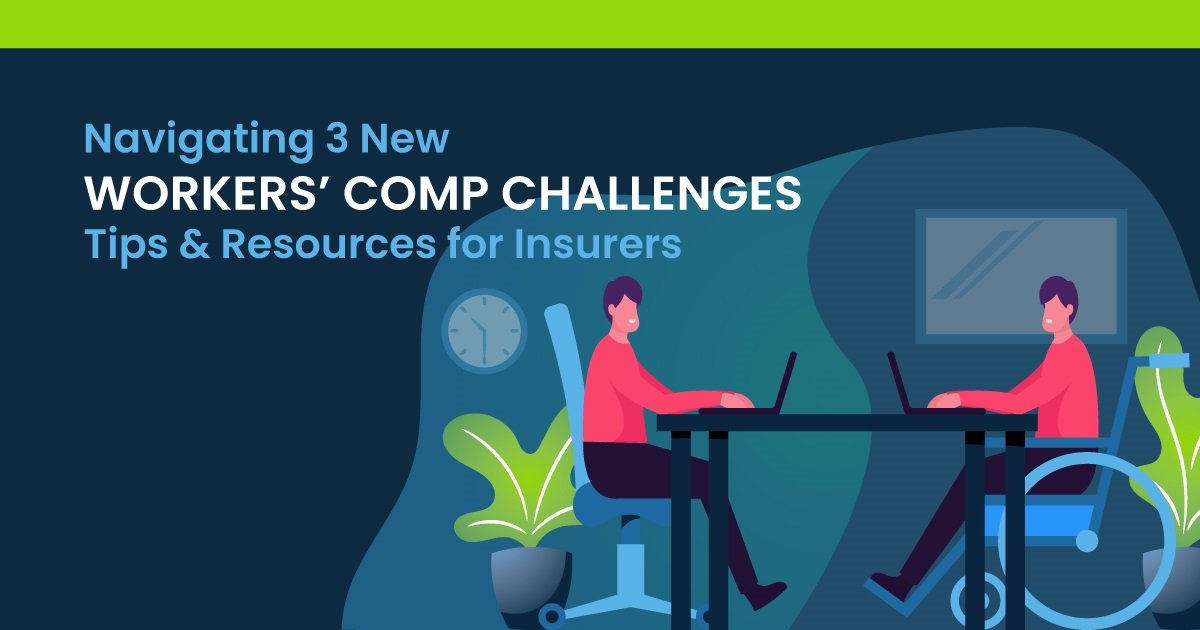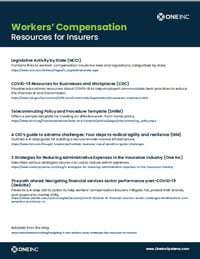| By Patricia Moore

Navigating 3 New Workers’ Comp Challenges: Tips & Resources for Insurers
Discussions about the coronavirus and workers’ compensation have dominated the industry since the early days of the pandemic. Who is responsible when an employee contracts the coronavirus on the job? How can employers ensure safe working conditions for their remote workers? What can be done to minimize losses in an economy stricken by turmoil?
The answers to such questions are relatively fluid, varying from one state to the next, and seeming to change almost as frequently as they are established. Luckily, the industry is ripe with resources to help workers' compensation insurers navigate some of these ongoing challenges as we continue to shape - and adapt to - the New Normal.
Challenge #1: COVID-19 Legal Disputes
Who pays when a claimant contracts the coronavirus at work?
Depending upon the state, industry, and workplace particulars, an employer’s responsibility can range from the presumed source of an employee’s illness (e.g., California SB-1159) to “total immunity from civil liability” (e.g., Oklahoma SB-1946). Workers’ comp professionals are braced for a potential slew of COVID-related claims and legal battles arising out of any exceptions, disputes, or ambiguity leftover from new legislation.
Tip: Stay Apprised
While nobody knows exactly how these issues will play out, insurers are paying close attention to trends and regulations in their states in an effort to be as prepared as possible. The National Council on Compensation Insurance (NCCI) monitors legislative activity in all jurisdictions, including the federal government. You can access their interactive map to stay apprised of developments in your own state.
Resource: Legislative Activity by State (NCCI map)
Tip: Educate Your Customers
You can also help your customers reduce the risk of workplace transmission by ensuring they have up-to-date information on how to protect their staff and customers. The Centers for Disease Control and Prevention (CDC) website contains a wealth of resources for businesses, including prevention, support, and mitigation strategies.
Resource: COVID-19 Resources for Businesses and Workplaces (CDC)
Challenge #2: Scattered Workforce
How can employers manage employee-safety in a remote work environment?
In response to the sudden onset of social distancing and shelter-in-place orders in March 2020, remote work increased dramatically, peaking at approximately two-thirds of the American workforce by the end of April. And while telecommuting is associated with a long list of documented benefits – including improved employee health, morale, and retention, along with reductions in overhead costs – one considerable drawback remains. With a dispersed staff, employers have little control over each employee’s work environment, which could lead to a liability nightmare if left unaddressed.
Tip: Create a Work-from-Home (WFH) Policy
As suggested in a recent WorkersCompensation.com article, employers should “use telecommuting agreements to keep remote work in check, attorneys advise.” The Society for Human Resources Management (SHRM) offers a sample “Telecommuting Policy and Procedure” template to use as a starting point. However, because the needs and circumstances can differ between organizations, it is always best to seek advice from a legal professional when developing your new company policy.
Resource: Telecommuting Policy and Procedure Template (SHRM)
Tip: Update Your Remote-Access Infrastructure
In addition to the WFH policy, having the appropriate physical and digital resources is critical for a secure, effective remote-access work environment. IBM recently developed a four-step action guide to help businesses of all sizes build a solid work-from-anywhere foundation. The guide offers clear and concise instructions for setting up your applications environment, network capacity, workplace, and operations.
Resource: A CIO’s guide to extreme challenges: Four steps to radical agility and resilience (IBM)
Challenge #3: Economic Impact
How can insurers minimize the fallout from this global economic crisis?
Between pandemic-related underwriting and investment losses, early forecasts estimate the insurance industry could lose up to $203 billion globally. Workers’ compensation challenges are compounded by the fact that policies and premiums are directly related to the size of the workforce, which has dramatically dropped in recent months. Additionally, the anticipated influx of work-related coronavirus claims could potentially cost the industry up to $81.5 billion in the United States alone.
Tip: Reduce Admin Expenses
While you may not be able to shield your business from all the challenges that lie ahead, you can help insulate your margins by lowering admin expenses. Automation, outsourcing, and digitization allow you to conserve resources and focus on the more complex issues that require greater insurance expertise. Streamlined operations also lead to a better customer experience, reducing the high cost of churn and subsequent acquisition efforts. You can find specific suggestions for cost-reduction strategies in the following One Inc article.
Resource: 3 Strategies for Reducing Administrative Expenses in the Insurance Industry (One Inc Blog)
Tip: Respond to Market Shifts
Adaptation will be key for any business to survive the extraordinary set of challenges we face today. Deloitte Center for Financial Services recommends workers’ comp insurers approach this economic instability by focusing on prudent underwriting, agility, claims efficiency, and reputational management. You can find their calls-to-action for workers' compensation insurers here.
Resource: The path ahead: Navigating financial services sector performance post-COVID-19 (Deloitte)
As the rapidly changing global conditions continue to shape the insurance industry, new challenges and questions will undoubtedly emerge. Staying connected to industry resources and organizations will be vital for the health and safety of your staff and customers, as well as for the longevity of your business.
Click the image to download the list of resources from this article:
You might also be interested in:
Unlocking the Power of Payments in Insurance
If you have any questions about how digital payments can help future-proof your company, contact One Inc.
Disclaimer:
All blog content - including, but not limited to, all text, images, multimedia elements, and links - is provided for informational purposes only, and does not, nor is it intended to, constitute medical or legal advice. All links to third-party websites are offered for the convenience of the reader and do not represent an endorsement. Although the authors make every attempt to authenticate facts, statistics, research, and analyses before publication, One Inc does not guarantee the accuracy or currentness of information provided. Please consult your attorney(s) for legal matters and your health professional(s) for medical matters. If you have any questions about One Inc or the One Inc Digital Payments Platform for insurance, please contact us here.
Tags: Industry Trends, Laws & Regulations, Workers' Comp

Written by Patricia Moore
Patricia is passionate about helping insurers continue to achieve success in a rapidly changing industry. She offers news, insights, and tips to help you modernize your organization, boost efficiency, and provide a superior customer experience for today’s policyholders.
Want to read more articles like this?



